Resources
Resources
Trust our materials to aid your staff and optimize your business while also equipping you to help reach pet owners.
Browse Resources
Internal Medicine & Dermatology
Pet Owner Resources

CPMA Pet Owner Education Pamphlet

Care Credit Financial Assistance for Pet Owners
Claro® (florfenicol, terbinafine, mometasone furoate) Otic Solution Resources
Bexacat™ (bexagliflozin tablets) Resources
Elura® (capromorelin oral solution) Resources
Entyce® (capromorelin oral solution) Resources

2021 Proceedings: Managing appetite disorders and weight loss in patients with chronic conditions
Tanovea® (rabacfosadine for injection) Resources
Varenzin™-CA1 (molidustat oral suspension) Resources
Sources of Zen

America's Itchy Dogs Report
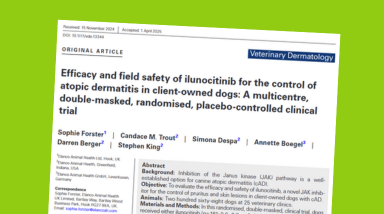
Peer-Reviewed Publication on the Efficacy and Field Safety of Zenrelia for the Control of Atopic Dermatitis in Client Owned Dogs
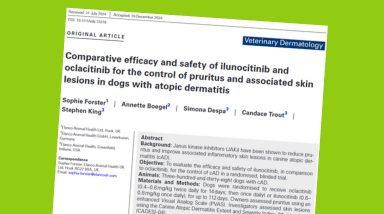
Peer-Reviewed Publication Comparing the Efficacy and Safety of Zenrelia to Apoquel
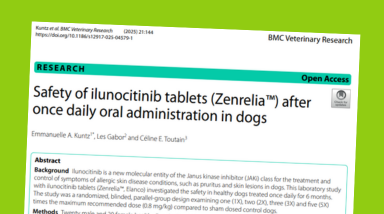
Peer-Reviewed Publication of the Target Animal Safety Study

Dosing Card
Use this dosing card as a quick reference to help choose the right dose for your patients when prescribing Zenrelia.
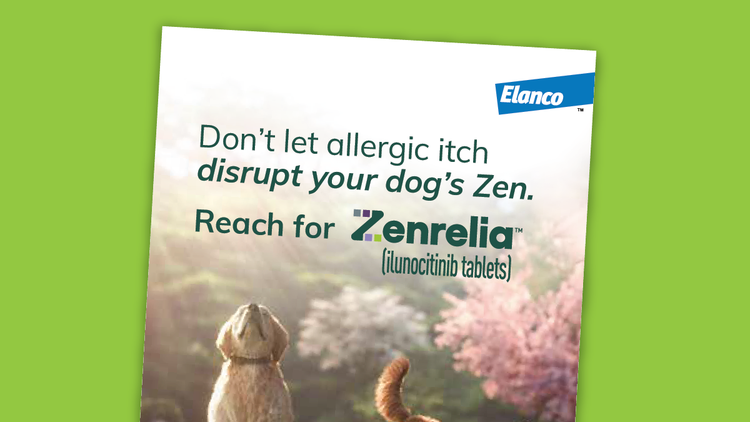
Product Brochure and Itch Tracker
Share this brochure with your clients and encourage them to use the itch tracker to monitor their dog's progress.
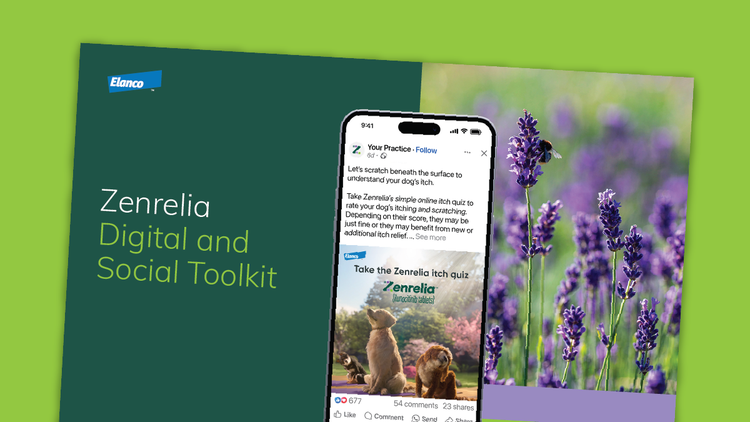
Digital and Social Toolkit
Use these social posts and images to let your clients know you have another way to treat their dog's allergic itch, and encourage them to make an appointment.
Orthopedic Health & Pain Management
Galliprant | Nocita | Onsior | Zorbium
Galliprant® (grapiprant tablets) Resources
Nocita®(bupivacaine liposome injectable suspension) Resources
Onsior® (robenacoxib) Resources
Zorbium® (buprenorphine transdermal solution) Resources
Advantage Multi® (imidacloprid + moxidectin) Resources
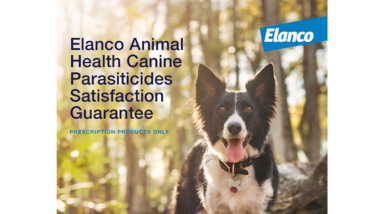
Canine Parasiticides Satisfaction Guarantee
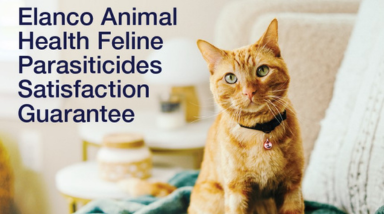
Feline Satisfaction Guarantee
Resources
Credelio® (lotilaner) Resources
Credelio® CAT (lotilaner) Resources
Interceptor® Plus (milbemycin oxime/praziquantel) Resources
Trifexis® (spinosad + milbemycin oxime) Resources
TruFel Resources
TruCan Resources
Claro® (florfenicol, terbinafine, mometasone furoate) Otic Solution
Indication: Claro® is indicated for the treatment of otitis externa in dogs associated with susceptible strains of yeast (Malassezia pachydermatis) and bacteria (Staphylococcus pseudintermedius).
Important Safety Information: CLARO should be administered by veterinary personnel. Wear eye protection when administering CLARO. Splatter may occur if the dog shakes its head following administration. Do not use in dogs with known tympanic membrane perforation. The integrity of the tympanic membrane should be confirmed before administering the product. CLARO has been associated with rupture of the tympanic membrane. Reevaluate the dog if hearing loss or signs of vestibular dysfunction are observed during treatment. Owners should be aware that adverse reactions may occur following administration of CLARO and should be instructed to observe the dog for signs such as ear pain and irritation, vomiting, head shaking, head tilt, incoordination, eye pain and ocular discharge. Owners should also be informed that splatter may occur if the dog shakes its head following administration of CLARO which may lead to ocular exposure. Eye injuries, including corneal ulcers, have been reported in humans and dogs associated with head shaking and splatter following administration. Owners should be careful to avoid ocular exposure.
(For full prescribing information see Claro package insert.)
Bexacat™ (bexagliflozin tablets)
Indication: Bexacat is indicated to improve glycemic control in otherwise healthy cats with diabetes mellitus not previously treated with insulin.
Important Safety Information: Before using this product, it is important to read the entire product insert, including the boxed warning. See package insert for full prescribing information. Cats treated with Bexacat may be at an increased risk of diabetic ketoacidosis or euglycemic diabetic ketoacidosis, both of which may result in death. Development of these conditions should be treated promptly, including insulin administration and discontinuation of Bexacat. Do not use Bexacat in cats with diabetes mellitus who have previously been treated with insulin, who are receiving insulin, or in cats with insulin-dependent diabetes mellitus. The use of Bexacat in cats with insulin-dependent diabetes mellitus, or the withdrawal of insulin and initiation of Bexacat, is associated with an increased risk of diabetic ketoacidosis or euglycemic diabetic ketoacidosis and death. Sudden onset of hyporexia/anorexia, lethargy, dehydration, diarrhea that is unresponsive to conventional therapy, or weight loss in cats receiving Bexacat should prompt immediate discontinuation of Bexacat and assessment for diabetic ketoacidosis, regardless of blood glucose level. Bexacat should not be initiated in cats with pancreatitis, anorexia, dehydration, or lethargy at the time of diagnosis of diabetes mellitus, as it may indicate the presence of other concurrent disease and increase the risk of diabetic ketoacidosis. Due to risk of severe adverse reactions, do not use Bexacat in cats with evidence of hepatic disease or reduced renal function. Consult a physician in case of accidental ingestion by humans.
Elura® (capromorelin oral solution)
Indication: Elura® is indicated for management of weight loss in cats with chronic kidney disease.
Important Safety Information: For oral use in cats only. Do not use in cats that have a hypersensitivity to capromorelin or in cats with hypersomatotropism (acromegaly). Elura® may increase serum glucose for several hours after dosing; use in cats with current or historical diabetes mellitus has not been evaluated and may not be appropriate. Use with caution in cats that may have cardiac disease, severe dehydration or hepatic dysfunction. Elura® has not been evaluated in cats younger than 5 months of age or in breeding, pregnant or lactating cats. The most common adverse reactions included vomiting, hypersalivation, inappetence, behavior change and lethargy. Please see Elura® product label for full prescribing information.
Entyce® (capromorelin oral solution)
Indication: For appetite stimulation in dogs.
Important Safety Information: For use in dogs only. Do not use in dogs that have a hypersensitivity to capromorelin. Use with caution in dogs with hepatic dysfunction or renal insufficiency. The safe use of Entyce has not been evaluated in breeding, pregnant or lactating dogs. The most common adverse reactions included diarrhea, vomiting, elevated blood urea nitrogen, polydipsia and hypersalivation.
Please see Entyce product label for full prescribing information.
Tanovea® (rabacfosadine for injection)
Indication: Tanovea is indicated for the treatment of lymphoma in dogs.
Important Safety Information: Tanovea is not for use in humans. Keep out of reach of children. Do not come into direct contact with Tanovea. Wear chemotherapy-resistant gloves to prevent contact with feces, urine, vomit, and saliva of treated dogs for five days following treatment. Rabacfosadine is cytotoxic and may cause birth defects and affect female and male fertility. Pregnant women, those who may become pregnant, and nursing women should not handle, prepare or administer the product. Tanovea is associated with life-threatening or fatal pulmonary fibrosis. Monitoring for signs of pulmonary dysfunction is recommended. Do not use in dogs with pulmonary fibrosis, a history of chronic pulmonary disease that could lead to fibrosis, or in breeds with a predisposition to this condition such as West Highland White Terriers. Use with caution in other terrier breeds. Do not use in dogs that are pregnant, lactating, or intended for breeding. Tanovea is associated with dermatopathies which can worsen with subsequent treatment; careful monitoring is recommended. Tanovea can cause neutropenia with nadir around seven days post-treatment. Dogs should be frequently monitored for evidence of neutropenia during treatment. Most common adverse reactions included diarrhea, decreased appetite, emesis, lethargy, weight loss and neutropenia.
Please see Tanovea product label for full Prescribing Information.
Varenzin™-CA1 (molidustat oral suspension)
Indication: Varenzin-CA1 is indicated for the control of nonregenerative anemia associated with chronic kidney disease (CKD) in cats.
Important Safety Information: For oral use in cats only. Keep this drug, including used syringes, out of reach of children. Wash hands immediately after use. In case of accidental ingestion, seek medical advice immediately. Women who are pregnant or may become pregnant should administer the product with caution. Varenzin-CA1 should not be administered to cats that are pregnant, lactating or intended for breeding or to cats with known hypersensitivity to molidustat or to any of the inactive ingredients. Use with caution in cats with a history of seizures and in cats predisposed to thromboembolic disease. Hematocrit (HCT) or packed cell volume (PCV) levels should be monitored regularly as polycythemia may result from use of Varenzin-CA1. Varenzin-CA1 has not been evaluated in cats less than 1 year of age. The most common adverse reactions included vomiting, increases in systolic blood pressure and mild transient increase in serum potassium. View product label.
Credelio® (lotilaner)
Indications: Credelio® (lotilaner) kills adult fleas and is indicated for the treatment and prevention of flea infestations (Ctenocephalides felis) and the treatment and control of tick infestations [Amblyomma americanum (lone star tick), Dermacentor variabilis (American dog tick), Ixodes scapularis (black-legged tick) and Rhipicephalus sanguineus (brown dog tick)] for one month in dogs and puppies 8 weeks of age and older and weighing 4.4 pounds or greater.
Important Safety Information: Lotilaner is a member of the isoxazoline class. This class has been associated with neurologic adverse reactions including tremors, ataxia, and seizures. Seizures have been reported in dogs receiving this class of drugs, even in dogs without a history of seizures. Use with caution in dogs with a history of seizures or neurologic disorders. The safe use of Credelio® in breeding, pregnant or lactating dogs has not been evaluated. The most frequently reported adverse reactions are weight loss, elevated blood urea nitrogen, polyuria, and diarrhea. For full prescribing information see the Credelio® package insert.
Credelio® CAT (lotilaner)
Indications: Credelio® CAT kills adult fleas and is indicated for the treatment and prevention of flea infestations (Ctenocephalides felis) for one month in cats and kittens 8 weeks of age and older and weighing 2.0 lbs or greater.
Credelio® CAT is also indicated for treatment and control of Ixodes scapularis (black-legged tick) infestations for one month in cats and kittens 6 months of age and older and weighing 2.0 lbs or greater.
Important Safety Information: Lotilaner is a member of the isoxazoline class. This class has been associated with neurologic adverse reactions including tremors, ataxia and seizures. Neurologic adverse reactions have been reported in cats receiving isoxazoline class drugs, even in cats without a history of neurologic disorders. Use with caution in cats with a history of neurologic disorders. The safety of Credelio® CAT has not been established in breeding, pregnant and lactating cats. The effectiveness of Credelio® CAT against Ixodes scapularis in kittens less than 6 months of age has not been evaluated. The most frequently reported adverse reactions are weight loss, tachypnea and vomiting. For full prescribing information see the Credelio® CAT package insert.
Interceptor® Plus (milbemycin oxime/praziquantel)
Indications: Interceptor Plus® Plus (milbemycin oxime/praziquantel) is indicated for the prevention of heartworm disease caused by Dirofilaria immitis and for the treatment and control of adult roundworm (Toxocara canis, Toxascaris leonina), adult hookworm (Ancylostoma caninum), adult whipworm (Trichuris vulpis), and adult tapeworm (Taenia pisiformis, Echinococcus multilocularis, Echinococcus granulosus and Dipylidium caninum) infections in dogs and puppies 6 weeks or older and 2 lbs or greater.
Important Safety Information: Treatment with fewer than 6 monthly doses after the last exposure to mosquitoes may not provide complete heartworm prevention. Prior to the administration of Interceptor Plus, dogs should be tested for existing heartworm infections. The safety of Interceptor® Plus has not been evaluated in dogs used for breeding or in lactating females. The following adverse reactions have been reported in dogs after administration of milbemycin oxime or praziquantel: vomiting, diarrhea, depression/lethargy, ataxia, anorexia, convulsions, weakness, and salivation. For full prescribing information see the Interceptor® Plus package insert.
Trifexis® (spinosad + milbemycin oxime)
Indications: Trifexis® is indicated for the prevention of heartworm disease (Dirofilaria immitis). Trifexis® kills fleas and is indicated for the prevention and treatment of flea infestations (Ctenocephalides felis), and the treatment and control of adult hookworm (Ancylostoma caninum), adult roundworm (Toxocara canis and Toxascaris leonina) and adult whipworm (Trichuris vulpis) infections in dogs and puppies 8 weeks of age or older and 5 pounds of body weight or greater.
Important Safety Information: Serious adverse reactions have been reported following concomitant extra-label use of ivermectin with spinosad alone, one of the components of Trifexis®. Treatment with fewer than three monthly doses after the last exposure to mosquitoes may not provide complete heartworm prevention. Prior to administration of Trifexis®, dogs should be tested for existing heartworm infection. Use with caution in breeding females. The safe use of Trifexis® in breeding males has not been evaluated. Use with caution in dogs with pre-existing epilepsy. The most common adverse reactions reported are vomiting, depression/lethargy, pruritus, anorexia, and diarrhea. To ensure heartworm prevention, dogs should be observed for one hour after administration. If vomiting occurs within one hour of administration, redose. Puppies less than 14 weeks of age may experience a higher rate of vomiting. For full prescribing information see Trifexis® package insert.
Galliprant® (grapiprant tablets)
Indication: Galliprant is an NSAID that controls pain and inflammation associated with osteoarthritis in dogs.
Important Safety Information: Not for use in humans. For use in dogs only. Keep this and all medications out of reach of children and pets. Store out of reach of dogs and other pets in a secured location in order to prevent accidental ingestion or overdose. Do not use in dogs that have a hypersensitivity to grapiprant. If Galliprant is used long-term, appropriate monitoring is recommended. Concomitant use of Galliprant with other anti-inflammatory drugs, such as COX-inhibiting NSAIDs or corticosteroids, should be avoided. Concurrent use with other anti-inflammatory drugs or protein-bound drugs has not been studied. The safe use of Galliprant has not been evaluated in dogs younger than 9 months of age and less than 8 lbs (3.6 kg), dogs used for breeding, pregnant or lactating dogs, or dogs with cardiac disease. The most common adverse reactions were vomiting, diarrhea, decreased appetite, and lethargy. Click here for full prescribing information.
Nocita®(bupivacaine liposome injectable suspension)
Indication: For single-dose infiltration into the surgical site to provide local postoperative analgesia for cranial cruciate ligament surgery in dogs. For use as a peripheral nerve block to provide regional postoperative analgesia following onychectomy in cats.
Important Safety Information: NOCITA is for use in dogs and cats only. Do not administer concurrently with bupivacaine HCl, lidocaine or other amide local anesthetics. The safe use of NOCITA in dogs and cats with cardiac disease or with hepatic or renal impairment has not been evaluated. The safe use in dogs or cats younger than 5 months of age, that are pregnant, lactating, or intended for breeding has not been evaluated. The most common adverse reactions in dogs were discharge from incision, incisional inflammation and vomiting. The most common adverse reactions in cats were elevated body temperature and infection or chewing/licking at the surgical site. Click here to view full product label.
Onsior® (robenacoxib) for Cats
Indications for Cats:
ONSIOR® tablets for Cats are indicated for the control of postoperative pain and inflammation associated with orthopedic surgery, ovariohysterectomy and castration, in cats ≥ 5.5 lbs and ≥ 4 months of age; for up to a maximum of 3 days.
ONSIOR® injection is indicated for the control of postoperative pain and inflammation associated with orthopedic surgery, ovariohysterectomy and castration in cats ≥ 4 months of age; for up to a maximum of 3 days.
Important Safety Information for Cats:
Do not use in cats that have hypersensitivity to robenacoxib or known intolerance to NSAIDs. Do not administer Onsior® tablets or injection in conjunction with any other NSAID or corticosteroid. Do not use for more than 3 days. A thorough history and physical exam including appropriate testing should be conducted before initiation of a NSAID therapy. Owners should be advised to observe for signs of potential drug toxicity. Stop administration of ONSIOR® if appetite decreases or if the cat becomes lethargic. The use of ONSIOR® has not been evaluated in cats used for breeding, or in pregnant or lactating cats or in cats with cardiac disease. As a class, cyclo-oxygenase inhibitory NSAIDS may be associated with gastrointestinal, renal, and hepatic toxicity. For full prescribing information see label links below.
ONSIOR® injection: For subcutaneous use in cats ≥ 4 months of age. Safety has not been demonstrated for intravenous or intramuscular administration. The most common adverse reactions were incision site infection, increased incision site bleeding, vomiting, inappetence and lethargy.
ONSIOR® tablets for Cats: For oral use in cats ≥ 5.5 lbs and ≥ 4 months of age only. The most common adverse events are anorexia, depression, vomiting, elevated BUN, elevated creatinine, and renal insufficiency/failure.
Zenrelia™ (ilunocitinib tablets) Indications
Zenrelia is indicated for control of pruritus associated with allergic dermatitis and control of atopic dermatitis in dogs at least 12 months of age.
Zenrelia™ (ilunocitinib tablets) Important Safety Information
Read the entire package insert before using this drug, including the Boxed Warning.
For full prescribing information call 1-888-545-5973 or visit http://www.elancolabels.com/us/zenrelia
WARNING: VACCINE-INDUCED DISEASE AND INADEQUATE IMMUNE RESPONSE TO VACCINES. Based on results of the vaccine response study, dogs receiving Zenrelia are at risk of fatal vaccine-induced disease and inadequate immune response to vaccines. Discontinue Zenrelia for at least 28 days to 3 months prior to vaccination and withhold Zenrelia for at least 28 days after vaccination. Dogs should be up to date on vaccinations prior to starting Zenrelia. Do not use in dogs less than 12 months old or dogs with a serious infection. Monitor dogs for infections because Zenrelia may increase susceptibility to opportunistic infections. Neoplastic conditions (benign and malignant) were observed during clinical studies. Consider the risks and benefits of treatment in dogs with a history of recurrence of these conditions. The most common adverse reactions were vomiting, diarrhea and lethargy. Zenrelia has not been evaluated in breeding, pregnant, or lactating dogs and concurrent use with glucocorticoids, cyclosporine, or other systemic immunosuppressive agents has not been tested. For full prescribing information see package insert.
Zorbium® (buprenorphine transdermal solution) for cats
Indication: ZORBIUM is indicated for the control of postoperative pain associated with surgical procedures in cats.
Important Safety Information: Before using ZORBIUM (buprenorphine transdermal solution), read the entire package insert including the Boxed Human Warning.
ZORBIUM contains buprenorphine, an opioid that exposes humans to risks of misuse, abuse and addiction, which can lead to overdose and death. Use of buprenorphine may lead to physical dependence. The risk of abuse by humans should be considered when storing, administering and disposing of ZORBIUM. Serious, life-threatening or fatal respiratory depression may occur with accidental exposure to or with misuse or abuse of ZORBIUM. ZORBIUM should only be administered by veterinarians or veterinarian technicians who are trained in the handling of potent opioids. Accidental exposure to even one tube of ZORBIUM, especially in children, can result in a fatal overdose.
ZORBIUM is for topical application in cats only. Do not come into direct contact with ZORBIUM. Wear impermeable latex or nitrile gloves, protective glasses and a laboratory coat when applying ZORBIUM. Following application to the cat, allow a minimum drying time of 30 minutes before direct contact with the application site. Do not administer to cats with a known hypersensitivity to buprenorphine hydrochloride, any inactive ingredients of ZORBIUM, or known intolerance to opioids. Do not apply ZORBIUM if the application site at the dorsal cervical area has diseased or injured skin, or to anatomic areas other than the dorsal cervical area because absorption characteristics may be different. Body temperature should be monitored postoperatively. Most common adverse reactions during anesthesia were hypothermia, hypotension and hypertension, and after anesthetic recovery were hypothermia, hyperthermia and sedation. The safe use of ZORBIUM has not been evaluated in debilitated cats; those with renal, hepatic, cardiac or respiratory disease; pregnant, lactating or breeding cats; in cats younger than four months old; or in cats <2.6 lbs. or >16.5 lbs.
